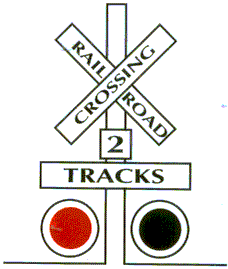| |
Caboose Facts | ||||||||||||||||||||||||
| · · · Who are we? · Caboose Facts · Caboose Photos · Virtual Tour · Story Book · Links · Contact us · · · | |||||||||||||||||||||||||
| ·
It was built in 1942 by PRR, at the Altoona shops. ·Its original PRR number was 477846. It remained a PRR caboose until 1968, when it became part of the Penn Central. It was then painted green, and renumbered 23108. ·In 1976, Conrail took over Penn Central and the caboose was painted blue. · Most well known class of cabin car · Conrail donated it. ·Height: 13' 5" · Length : 30' · Weight: 25 tons · The five main items in the caboose are the wheel stop, brake, conductor's valve, air valve and a ladder to see out of the cupola. · ·The caboose sits on two sets of trucks (wheels). The axle rotates the trucks. The phalange keeps the trucks in place (a phalange is the groove that keeps the train on the track). · Front side had the coupler that kept the trains together while on the track. · Underneath the caboose there were air hoses and water boxes, and most important the brake shoe and air brakes. · The track was made of iron in 60' to 90' sections and most were made in Bethlehem PA. ·PRR also considered itself to be the keystone of US railroading. The Pennsy, which lasted 121 years, was the largest railroad in the world for most of its time. At its height, it operated over 10,000 miles of track and moved more freight and passengers than any other railroad. · The Official Travelers Railway Guide of the United States and Canada was used in the late 1800's and early 1900's and a copy reprinted for the 100 anniversary is in our caboose. · Commonly referred to as the cabin car with round windows and had a modern streamlined cupola · Each year, from 1925 to 1958, PRR distributed a large advertising calendar with scenic pictures painted on them. It was distributed to customers and railroad friends free of charge. (photo soon available of calendar) · The crew of the caboose consisted of three people the conductor, rear brakemen, and the flagman. · The brakemen were some of the most important people due to if the brakes caught fire they had to put it out quickly without disrupting the rest of the train. While he was not attending to the brakes he gave signals to the conductor and helped him load and unload the freight. · The fireman helped the brakeman put out brake fires if there happened to be one. · The conductor saw that the train did its job and had to make sure that everything was in order before departing and after arriving. · The caboose is the HQ for the crew when they are not on active duty. · The caboose is where the conductor writes up reports and does all the work he needs to get done. · The PRR acquired its name, from the Keystone State. The · The flagman flagged the rear and front of the train to deliver important news about the train. · Lanterns were used to signal movement, speed, and stopping trains. This was later replaced with electronic signaling devices. · Signals were used to send messages. These signals were very important in trains. There were a variety of things used for signals. · Every one knows that the whistlers are at a crossing on the road when a train is coming and signal you to stop.
|
|||||||||||||||||||||||||
